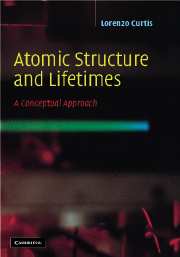Book contents
- Frontmatter
- Contents
- Preface
- List of physical constants and useful interrelations
- 1 Introduction
- 2 Semiclassical conceptual models
- 3 Semiempirical parametrization of energy-level data
- 4 The vector model of angular momentum
- 5 The intermediate coupling model
- 6 Electric dipole radiation
- 7 Line strengths in two-valence-electron systems
- 8 Magnetic dipole transitions
- 9 Absorption of radiation
- 10 Time-resolved measurements
- 11 Hyperfine structure
- 12 Electrostatic polarizabilities and long-range interactions
- 13 Coherence and anisotropic excitation
- References
- Index
5 - The intermediate coupling model
Published online by Cambridge University Press: 06 July 2010
- Frontmatter
- Contents
- Preface
- List of physical constants and useful interrelations
- 1 Introduction
- 2 Semiclassical conceptual models
- 3 Semiempirical parametrization of energy-level data
- 4 The vector model of angular momentum
- 5 The intermediate coupling model
- 6 Electric dipole radiation
- 7 Line strengths in two-valence-electron systems
- 8 Magnetic dipole transitions
- 9 Absorption of radiation
- 10 Time-resolved measurements
- 11 Hyperfine structure
- 12 Electrostatic polarizabilities and long-range interactions
- 13 Coherence and anisotropic excitation
- References
- Index
Summary
Sic transit gloria uni electroni.
Spectroscopic notation
The nomenclature that is used to describe measured quantities in atomic spectroscopy is very much governed by the approximations inherent in the Schrödinger equation. Two theoretical approximations are particularly important. One is the central-field approximation, in which a many-electron atom is described by wave functions that are constructed from products of one-electron states. Another is the nonrelativistic approximation, which leads to a separation of the space and spin portions of the wave function.
A one-electron atomic state is defined by the hydrogenic basis state of quantum numbers |n l ml ms〉, where states with a common value of n are denoted as a “shell” and states with common values of n and l are denoted as a subshell. Since the electron–electron interaction is treated in an averaged manner by the central-field approximation, and the spin and space portions are treated as independent by the nonrelativistic approximation, electrons with the same value of n and l are treated as “equivalent.” As in the case of hydrogen, each electron is assigned a set of n and l quantum numbers, to yield a “configuration.” Here the numerical values of l are replaced by letters according to the code s, p, d for l = 0, 1, 2 and f, g, h, etc., for l = 3, 4, 5 etc., (alphabetically from f with the letter j omitted), with a superscript to describe the number of equivalent electrons in each subshell. This notation was originally formalized in a 1929 meeting that was attended by most of the leading spectroscopists of that era.
- Type
- Chapter
- Information
- Atomic Structure and LifetimesA Conceptual Approach, pp. 90 - 112Publisher: Cambridge University PressPrint publication year: 2003



